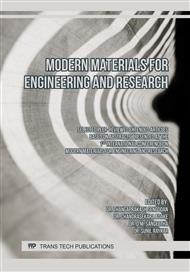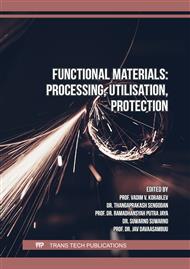[1]
S. Chaudhary, K. Rakesh, Natural Corrosion Inhibition and Adsorption Characteristics of Tribulus terrestris Plant Extract on Aluminium in Hydrochloric Acid. Biointerface Res. Appl. Chem. 2022 (12) 2603 – 2617.
DOI: 10.33263/BRIAC122.26032617
Google Scholar
[2]
A. Zaher, A. Chaouiki, R. Salghi, A. Boukhraz, B. Bourkhiss, M. Ouhssine, Inhibition of Mild Steel Corrosion in 1M Hydrochloric Medium by the Methanolic Extract of Ammi visnaga L. Lam Seeds. Int. J. Corros. 2020 (2020).
DOI: 10.1155/2020/9764206
Google Scholar
[3]
G.Pandey, ChV Rao, Review on Andrographis Paniculata wall. ex Nees: Its Traditional Use, Secondary Metabolite Production, Phytochemistry, Pharmacology and Products Developed . Research and Reviews: J. Pharmacog. Phytochem. 2017 (5) 23-40.
Google Scholar
[4]
W-W Chao, B-F Lin, Review Isolation and identification of bioactive compounds in Andrographis paniculata (Chuanxinlian), Chinese Med. 2010 (5) 1-15. http://www.cmjournal.org/content/5/1/17
DOI: 10.1186/1749-8546-5-17
Google Scholar
[5]
E. A. Noor, Temperature effects on the corrosion inhibition of mild steel in acidic solutions by aqueous extract of fenugreek leaves. Int. J. Electrochem. 2007 (2) 996–1017.
Google Scholar
[6]
O. Oloyede, Chemical profile of unripe pulp of Carica papaya,Pakistan J. Nutrit. 2005(4) 379–81. https;//doi.org/10. 3923/pjn.2005.379.381.
DOI: 10.3923/pjn.2005.379.381
Google Scholar
[7]
F. Mojab, M. Kamalinejad, N. Ghaderi, H. R. Vahidipour, Phytochemical screening of some species of Iranian plants, Iranian J. Pharmaceut. Res. 2003(2) 77–83. https://doi. org/
Google Scholar
[8]
O. Oyewole, E. Aondoakaa, T.S. Abayomi, S.J. Ogundipe, T.A. Oshin, Characterization and optimization study of Ficus exasperata extract as corrosion inhibitor for mild steel in seawater. World Sci. News. 2021(151) 78–94.
Google Scholar
[9]
V. Pourzarghan, B. Fazeli-Nasab, The use of Robinia pseudoacacia L fruit extract as a green corrosion inhibitor in the protection of copper-based objects , Herit. Sci. (2021) 9:75
DOI: 10.1186/s40494-021-00545-w
Google Scholar
[10]
A.O. Yüce, Corrosion inhibition behavior of Robinia pseudoacacia leaves extract as a eco-friendly inhibitor on mild steel in acidic media. Met. Mater Int. 2020 (26) 456–66
DOI: 10.1007/s12540-019-00509-7
Google Scholar



